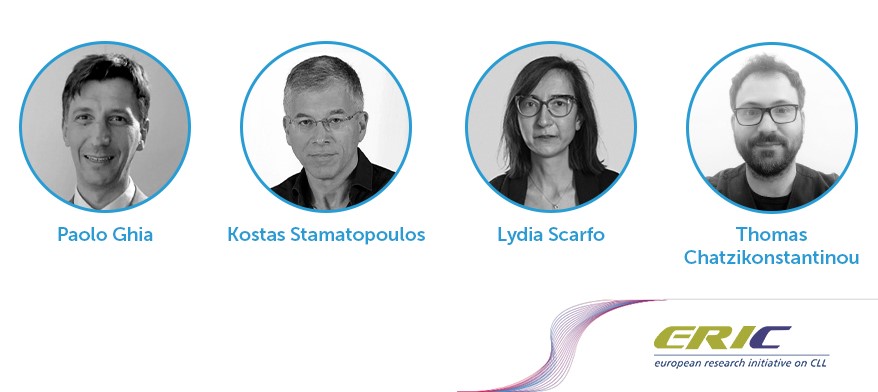Home> News> New results in treatments and risk factors that increase the chances of chronic lymphocytic leukemia patients developing other malignancies
December 05, 2023 14:46 - x 00, 0 - 00:00
Press Release | The Hague, 5 December 2023
Patients with chronic lymphocytic leukemia (CLL) have a higher risk of developing a second malignancy. However, which risk factors related to CLL or which treatments directed at CLL increase the chances of this occurring? A large retrospective study within the context of HARMONY has shed more light on this matter. Several risk factors and certain treatments were found to be clearly associated with the development of other malignancies. The findings will help physicians to make more appropriate treatment choices, particularly in younger patients with favorable disease characteristics.
HARMONY Partner Thomas Chatzikonstantinou of ERIC and the Institute of Applied Biosciences, Centre for Research and Technology Hellas (INAB|CERTH): “Our study shows that patients with chronic lymphocytic leukemia are more likely to develop acute myeloid leukemia and myelodysplastic syndromes when treated with a particular combination of chemotherapeutics called FCR (fludarabine, cyclophosphamide and rituximab). Patients who develop these types of second hematological cancers have an extremely poor prognosis”.
CLL is the most common leukemia in the Western world. Patients with CLL have inherent and therapy-related immune defects that can make them more susceptible to developing other malignancies (OM). Previous research had shown that CLL patients have a higher risk of developing a second OM than the general population and that the overall survival (OS) of these patients is lower than patients with CLL and without OM. In particular, patients with CLL treated with chemotherapy seemed to have a higher risk of therapy-related myelodysplastic syndrome (tMDS) and acute myeloid leukemia (tAML). Furthermore, little is known about the impact of novel agents like Bruton’s tyrosine kinase (BTK) or BCL2 inhibitors on the occurrence of OMs and the CLL-associated risk factors also remain elusive.
Therefore, an international team of researchers from the European Research Initiative on CLL (ERIC) led by Paolo Ghia, Kostas Stamatopoulos, Lydia Scarfo, and Thomas Chatzikonstantinou carried out a large international study within the context of HARMONY in order to assess the spectrum and incidence of OMs that occur in patients with CLL and to detect potential risk factors for developing OMs.
They selected a cohort of 19,705 patients with CLL, small lymphocytic lymphoma, or high-count CLL-like monoclonal B-cell lymphocytosis. These patients were diagnosed between 2000 and 2016, and the data were collected retrospectively between October 2020 and March 2022. A total of 3513 OMs were diagnosed after the diagnosis of CLL (27.2 OMs/1000 person-years). The most common hematological OMs were Richter transformation, myelodysplastic syndrome (MDS), and acute myeloid leukemia (AML). CLL patients with AML and MDS had the worst OS. Treatment with fludarabine and cyclophosphamide with or without rituximab (F C± R) were the only treatment-related predictors for MDS and AML development. No events occurred in patients treated exclusively with novel agents, though the follow-up was still limited. Male sex and unmutated immunoglobulin heavy variable genes were found to be CLL-associated risk factors for developing solid tumors. Non-melanoma skin (NMSC) and prostate cancers were the most common solid tumors found. CLL-directed treatment was associated with non-melanoma skin and prostate cancers, whereas breast cancers were more frequent in untreated patients.
These results show that the impact of CLL-directed treatment on the type of OM is highly variable, which might explain the conflicting results seen in previous smaller studies. Although the association between treatment with FC ± R regimen and an increased risk of developing AML or MDS is clear, the true impact of novel agents remains uncertain. Studies with longer follow-ups of patients treated with solely novel agents are needed to reveal their true impact on the occurrence of OMs.
HARMONY Partner Paolo Ghia, President of the European Research Initiative on CLL (ERIC): “The results achieved by this collaborative effort, including patients from 85 institutions and 28 countries, shows once more that the possibility to achieve meaningful conclusions strictly depends on the capacity to study large cohorts of patients in a harmonized fashion”.
Link to the HARMONY Alliance CLL Research Projects:
Leaders of the ERIC/HARMONY Research Team:

Listen to Thomas Chatzikonstantinou about the ERIC/HARMONY CLL Research:
HARMONY Big Data Platform
The HARMONY Alliance is a community with over 500 professionals and approx. 128 partners/member organizations from 28 European countries. When HARMONY started in 2017, the hematology community was embarking on a journey towards embracing data sharing and recognizing the transformative power of big data. HARMONY set a crucial milestone when this endeavor was only starting. By laying the foundation for future collaborations, advancements, and discoveries that would incorporate state-of-the-art technologies in the field of hematology, HARMONY is making its contribution to improving the understanding and treatment of blood disorders.
Now, just 6,5 years later, we have transformed both the sharing and the use of data. We have developed the Big Data Platform with a data lake over 165,000 patient records identified. All data is protected using a unique anonymization and security process. In more than 30 research projects, groundbreaking research is being carried out with the help of advanced customized data analytic services, including AI modelling.
More information
Contact: Ellen de Waal, EHA | HARMONY Lead Communications | communications@harmony-alliance.eu
www.harmony-alliance.eu | www.bigdataforbloodcancer.eu | @HARMONYNetEU
The HARMONY Alliance is funded through the Innovative Health Initiative). Funding is received from the IMI 2 Joint Undertaking and is listed under grant agreement for HARMONY No. 116026 and grant agreement for HARMONY PLUS No. 945406. This Joint Undertaking receives support from the European Union’s Horizon 2020 Research and Innovation Programme and the European Federation of Pharmaceutical Industries and Associations (EFPIA).
Receive the latest news. Click here to subscribe!